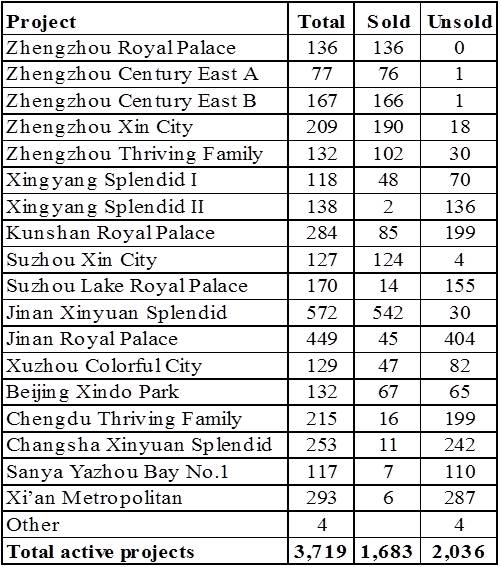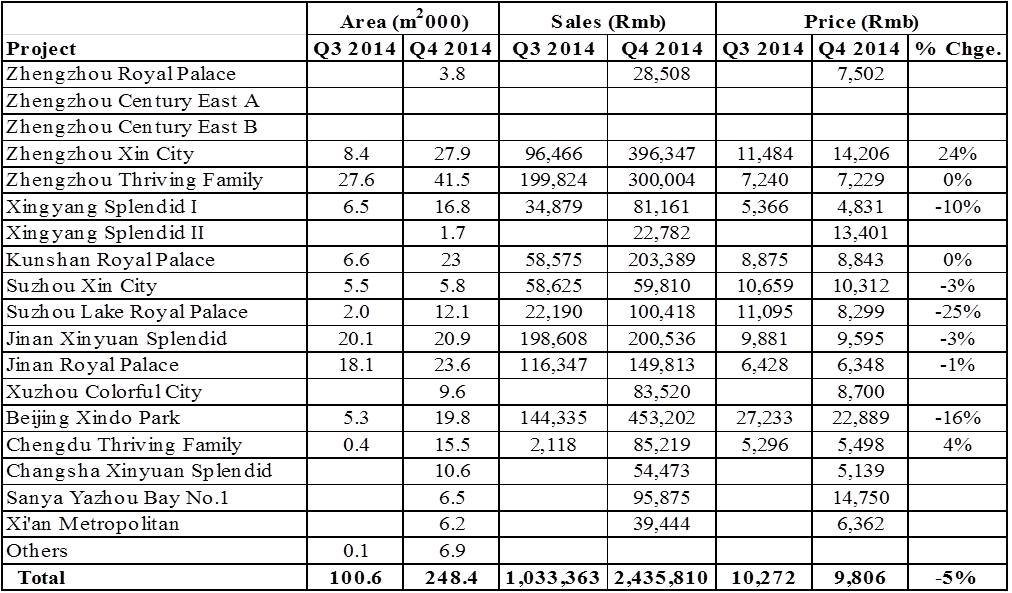Introduction
We have all heard the positive sounding news: fourth quarter revenues of US$362 million, a 121% increase from third quarter of 2014; contract sales of $402 million, which is a 140% increase from the third quarter of 2014. These numbers are really a testimony to just how bad the Chinese real estate market was the third quarter.
The annual headline comparisons are a bit more sobering than the quarterly comparisons: revenues up only 2.5% to $920 million in 2014 and floor area sales down 5.5% to 629,000 square meters. We then get to the important number for shareholders: net income down 61% from $126 million in 2013 to $48 million in 2014.
In my last piece on Xinyuan Xinyuan Real Estate (NYSE:XIN), I posed several questions that the 4th quarter results would help to clarify. That data is now available. In what follows, I use the latest data to address questions regarding the future economic well-being of the company.
Real estate involves borrowing money to buy land and building properties. Profits depend on selling for more than the cost of the land and properties built. Profit growth depends on holding costs down and while selling more and increasing the property/building inventory.
a. Inventories and Sales
Consider first inventories. Table 1 indicates that “active” inventories were 2,036,000 square meters at the end of 2014. That is up from 1,047,000 square meters at the end of the third quarter.
Active Projects: Floor Area (m2 000), end 2014
Source: XIN 6-K Documents
In addition, XIN has reported on planned projects (Table 2). Putting active and planned projects together, XIN has a healthy 3,080,000 square meter inventory going forward. One unexplained note: at the conference call, Yong Zhang, the Chairman of XIN talked of having launched 8 projects outside of China….
Xinyuan Planned Projects
Source: XIN 6-K Documents
2. Prices, Sales and Projected Profits
Table 3 provides sales and price data for XIN. Sales in the 4th quarter were up substantially. There has been slight erosion in prices in the latest quarter, most notably in Suzhou and Beijing.
XIN Sales: Area, Prices and Values
Source: XIN 6-K Documents
XIN reports that with sales of $2.6 billion, 66% of costs of its active projects have been recovered. This suggests its total costs for active projects will be $4 billion or an additional $1.3 billion. Assuming XIN is correct on its selling prices it will receive an additional $3.5 billion for the remainder of its active inventory. That would leave a profit of $2.2 billion. That is a significant amount for XIN when you consider its total liabilities are $2.3 billion.
3. Dividends and Buybacks
Western shareholders like dividends and buybacks. AS mentioned above, XIN reported 2014 net income at $48 million, down by 60% from 2013 ($126 million). At the current rate of 20 cents per diluted ADS, dividend payments total $14.9 million annually, or about 30% of net income. That is not an abnormally high share of profits for dividends. But it is likely XIN management has discussed a lower dividend rate.
XIN reported purchasing 4.5 million of its shares in 2014 at an average cost of $3.77 per share (too bad they did not wait until the price fell to around $2 in late January).
4. Equity Finance
Currently, XIN’s borrowing costs are high, at least by US standards. It pays about 10% overall with a bit lees for construction borrowing. At the recent press conference Manbo He, XIN’s CFO, said: “As we go forward to tackle new market opportunities, we are also trying to find new ways to finance our projects, including getting into some of equity cooperation with other organizations….” He talked of “some new creative and more productive ways of financing our new projects.”
This suggests at least two equity finance possibilities, one good and one bad. The bad one is to issue equity shores in return for financing. This is bad because at XIN’s current share price, a lot of shares would have to be given up for finance. A better option would be project specific financing. All the big Western finance houses make regular visits to major Asian cities, looking for projects to finance. These outfits like to get in and out quickly, so they often ask for a disproportionate share of revenues up front, but in return will leave a lot of potential profit on the table for the developers. Table X gives a fictitious example of this. Suppose Carlyle agrees to invest $40 million in a project with XIN costing $100 million and an overall profit of 140% coming equally over 4 years. Carlyle might ask for all income until it has made 20%. In return, it would the remaining profit to XIN. How this hypothetical example would work is illustrated in the following table.
In this fictitious example, Carlyle is avoiding all risk by getting paid first. Many traditional Chinese real estate companies will not accept this, insisting instead on proportionate payments by period. However, for a real estate company that is pretty sure of its projections, this sort of deal provides a way to increase its returns without giving up shares.
5. Real Estate Market Conditions
CFO Mambo He said the real estate market conditions in China improved in the 4th quarter as the result of government policies. After the conference call, the Chinese government announced a further lowering of interest rates: “For the second time in less than four months, the People’s Bank of China has cut interest rates, lowering by a quarter percentage point both the benchmark one-year loan rate, to 5.35%, and the one-year deposit rate, to 2.5%.”Deflationary risk and the property market slowdown are two main reasons for the rate cut this time,” said a central bank official.”
This suggests strongly that the real estate market in China will strengthen further.
Assessment and Investment Implications
There is something to be said for being at the right place at the right time. The growth of both population and GDP in the secondary cities of China continues at a rate not seen in the developed world. This provides a real opportunity for a well-managed real estate development company to make a lot of money. But real estate development is a risky business. The timing has to be right: the timing, location, and financing all have to be right.
XIN has gotten though the brief government-imposed slowdown in pretty good shape. And it has a healthy inventory lined up for sale in the coming months. It should be able to get its income up to $90-95 million as it has projected for 2015.
There are also a couple of concerns:
a. I hope it does not spread its development work too broadly: where are those 8 projects outside of China that Chairman Yong Zhang mentioned?
b. Financing: I think it is fair to say that to date, XIN has not done a stellar job in attracting Western investors. The TPG initiative has not gone down well. And XIN is now talking about more equity financing. For reasons discussed above, I hope it does this on a project-by-project basis.
While XIN appears to be doing an okay job in real estate, its performance as a NYSE-listed stock leaves a lot to be desired. As CFO Manbo He said in the recent conference call, most outside investors have little understanding of just how dynamic the Chinese real estate market is. To remedy this, XIN should put out regular press releases to provide some information on where they are investing and why. And show pictures!
Another point: when two Board members resign at the same time, outsiders worry. We just learned that both were over 70 years of age. This is of relevance. Explain this in a press release and talk about the sort of new Board members you want to attract.
Putting everything together, the next two years should be very good for XIN. If and when XIN cuts its dividend, its price will fall. That would be a great time to buy more.




